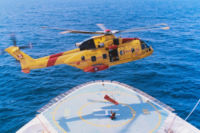CH-149 Cormorant: Difference between revisions
HTFUAlberta (talk | contribs) No edit summary |
HTFUAlberta (talk | contribs) No edit summary |
||
| Line 33: | Line 33: | ||
|} | |} | ||
|} | |} | ||
The Agusta-Westland CH-149 Cormorant, is a fully certified off-the-shelf civilian utility helicopter. It has been modified from the military specifications of the EH-101 to include search and rescue-specific equipment and physical characteristics and performance requirements to meet Canada’s SAR responsibilities. This modification provided reduced procurement costs, a rear-fuselage ramp, a single rescue door with both hoists on one side, and eliminated unnecessary military equipment. | |||
Shaped rotor blades, strengthened by titanium strips along the leading edge, allow the CH-149 to improve lift and increase speed, lowering the stall speed and reducing vibration. This enables it to withstand high winds (exceeding 50 knots), provide superior gust response while carrying out routine tasks of hoisting, starting and stopping. | |||
[http://www.airforce.forces.gc.ca/equip/ch-149/intro_e.asp] | |||
Revision as of 11:24, 31 July 2006
|
The Agusta-Westland CH-149 Cormorant, is a fully certified off-the-shelf civilian utility helicopter. It has been modified from the military specifications of the EH-101 to include search and rescue-specific equipment and physical characteristics and performance requirements to meet Canada’s SAR responsibilities. This modification provided reduced procurement costs, a rear-fuselage ramp, a single rescue door with both hoists on one side, and eliminated unnecessary military equipment.
Shaped rotor blades, strengthened by titanium strips along the leading edge, allow the CH-149 to improve lift and increase speed, lowering the stall speed and reducing vibration. This enables it to withstand high winds (exceeding 50 knots), provide superior gust response while carrying out routine tasks of hoisting, starting and stopping.
